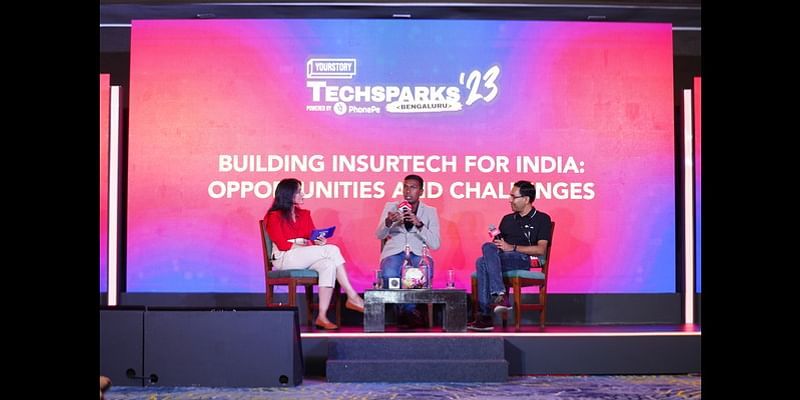How PhonePe’s tech-driven approach is transforming the insurance landscape in India
At a panel discussion at TechSparks 2023 Bengaluru edition, industry experts discussed how PhonePe is leading digital transformation in the insurance sector, and how personalisation, affordability, and technology are reshaping traditional industries.
In the dynamic world of fintech, where digital innovation is reshaping traditional industries, the intersection of technology and financial services presents a unique set of challenges and opportunities.
To delve into a discussion on this intersection, TechSparks 2023, the destination for deliberating, deep-diving, and understanding the promise of India's Great Indian Techade, hosted a panel of eminent experts: Srijon Biswas, Head of Engineering, BFSI at ; and Ramesh Perumalsamy Head of Engineering, Insurance at PhonePe. The session was led by Priya Patankar, Head of Communications at PhonePe.
PhonePe's journey into the insurance sector began three and a half years ago, a testament to its commitment to expand beyond its core payments and digital wallet services. The company recognised the potential in the insurance market and embarked on a mission to revolutionise it through digitalisation.
Understanding the Indian insurance landscape
Patankar shed light on how traditional insurance in India has largely been a brick-and-mortar affair, with agents playing a central role. The transition to a digital landscape required significant mindset shifts among traditional insurance providers. While digital transformation has been a compelling narrative, it necessitated changes at various levels, from leadership to operational processes. The initial challenge for PhonePe was getting its insurance partners to recognise the unique aspects of the digital journey.
"In recent times, we're witnessing the emergence of both major and niche players in India's mass market, driving innovation at a somewhat slower pace. I recall a fascinating case where a company parsed insurance PDFs to help users understand their coverage and gaps. Our journey has been about helping partners transition from a traditional mindset to embracing the digital landscape. It's not just about the product but transforming processes, scaling technology, and rethinking our approach. India has a long way to go, but it's an exciting journey,” Biswas shared.
The role of personalisation
One critical aspect of PhonePe's approach to insurance is personalisation. Personalisation in insurance extends beyond offering what customers want; it involves providing what they need.
In India, affordability is a key consideration. PhonePe addressed this by introducing monthly instalment plans for health insurance, making it more accessible to a broader audience.
They emphasise affordability by offering a diverse range of products that span various price ranges, catering to a broad spectrum of customers. These offerings encompass budget-friendly choices as well as comprehensive coverage options.
Perumalsamy highlights how PhonePe has effectively reached out to people in Tier II and Tier III cities, becoming a prominent digital channel for insurance distribution. The strategy is about being there at the right time for the customer, without overwhelming them with unwanted communication.
"Our primary challenge was helping our partners transition from the traditional offline insurance model to a digital platform. The goal was to scale and reach all of India's population. In 2020, we launched motor insurance, and it wasn't without its sceptics. However, within the first two days, our scale had a significant impact.
“Our reach of over 250 million ecosystem users transformed it from a push product to a pull product, changing mindsets. Luckily, our DNA has always been built for scale, and we've supported our partners through this symbiotic journey. We've achieved more than six million policies in a short time, exceeding our partners' expectations. It's been a challenging but rewarding journey,” Perumalsamy said.
Speaking about digitalisation, Biswas emphasised the importance of simplifying the customer journey. He said the product should be easy to understand and use, even for customers with little prior knowledge of insurance. The ultimate goal is to enable customers to complete the process on their own, ensuring accessibility for all.
Technology and engineering
The technology and engineering aspects of PhonePe's transformation are equally impressive. Biswas explained that the company’s vision is to build for scalability. From the outset, the focus was on building systems capable of handling a vast user base and working closely with insurance partners to overcome technical challenges.
Perumalsamy pointed out that building for scale has been critical to accommodate the vast and diverse user base, with over 490 million registered users and widespread adoption in Tier II and Tier III cities.
Furthermore, PhonePe relies on data and machine learning for customer profiling and recommending the right insurance products. Its ML models work to identify risk propensity and better understand customer behaviour. This approach allows for more personalised offerings, making it a win-win for both customers and insurers.
Challenges in the BFSI Sector
One of the most significant challenges in the BFSI sector is education and awareness of insurance products, particularly in a digital context.
Biswas said it's not just about offering a product but also making customers aware of the need for it. Unlike some other industries, insurance is a ‘need’, not a ‘want’. The focus is on being top of mind for customers and effectively reaching out to them at the right moment, without inundating them with information.
Perumalsamy noted that compared to other industries, the BFSI sector faces different challenges in digitalisation. He highlighted the push vs. pull nature of insurance, emphasising that customers need a push to understand and purchase insurance products due to their essential nature. This requires more thoughtful, empathetic, and nuanced strategies.
Digitalisation of insurance claims
While purchasing an insurance policy is one aspect, the claims process remains a critical phase. Perumalsamy said the insurance industry has earned a reputation for being opaque and challenging to navigate due to years of complexity and lack of transparency. PhonePe is committed to addressing this challenge and enhancing the customer experience, making both, the pre-purchase and claims journey, more transparent and straightforward.
Empowering engineers in fintech
Both panellists stressed that engineers should cultivate patience, empathy, and a deep understanding of the customer's problem to create impactful solutions. Understanding compliance, security, and traditional processes is equally crucial.
PhonePe encourages its engineers to think about automation and process improvement, especially when dealing with traditional insurance processes. The company's engineers are expected to understand compliance and risk mitigation, building a more holistic perspective beyond just writing code.
Charting a new path
The journey of digital transformation in the insurance sector is a compelling example of how technology and engineering can reshape traditional industries.
PhonePe's innovative approach to insurance has focused on personalisation, affordability, and transparency. With a focus on customer education and efficient claims processing, PhonePe is pushing the boundaries of fintech in India, creating a bright future for the insurance sector.












